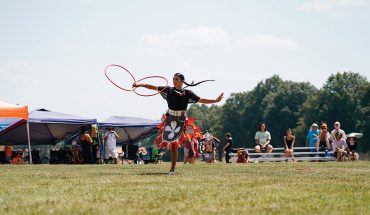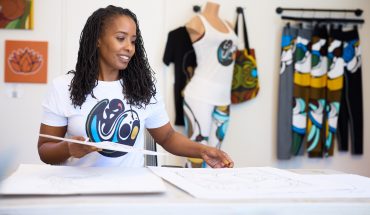text and photographs by Vansana Nolintha
My heart sank deep into my belly as the Lao Airlines plane lowered its chest to touch down in a place I have come to dream of as home. I was on the last leg of a 44-hour trip from Raleigh to cremate the remains of my 105-year-old grandmother.
Home has become a fluid concept in my life since I left Laos 16 years ago, alone at the age of 12, to come to the United States. For my first few years in Greensboro, I longed for familiarities: the morning bicycle ride to school with my friends through foggy rice fields; my grandmother’s herb garden and her insistence on collecting their seeds, not their leaves; my mother’s ritual of offering exactly two silver bowls of water, three sticks of incense, two yellow candles, and five sets of fragrant white plumeria flowers to the Buddha statue every morning and every night; the familiar taste of my parents’ cooking.
To a 12-year-old Laotian immigrant, North Carolina was the strangest land, and home was a long way away. I still remember Roberta Hoyle, my first American teacher at Aycock Middle School, asking me what I wanted for my first Christmas. I told her that more than anything else I wished mom and dad were here so they could pack my lunch. I was jealous of my American classmates and their familiarities.
Time, though, changes what’s familiar. I became a U.S. citizen right before I began college at N.C. State, and this new freedom granted me new familiarities. Over my few years at N.C. State and Trinity College in Dublin, I traveled, volunteered, and lived in more than 30 countries; studied four different academic disciplines, and learned to confront my aloneness by surrounding myself with busyness and passionate and energetic people. Slowly, the picture of my home faded into colors and memories. Laos became my distant and pictorial home, the one I constantly missed, but not necessarily the one where I thought I belonged. Being away from home became my home – and its picture was of a crossroad.
 Mother of life
Mother of life
Over the past 16 years, I have spent a total of about 50 days with my family. On all of my trips to Laos, I have adopted the ritual of always sitting at the window seat during the last leg of my journey. This tradition has become meaningful as it is on this leg that we cross the Mekong River from Thailand into Laos.
In our Buddhist tradition, rivers are revered as the most sacred host and provider. In fact, Mekong is translated literally in Laotian to Mother Kong, mother of life, as she stretches long and gracious, streaming into the fertile heart of Southeast Asia.
On this trip, I touched my hands to my forehead as I saw her in the distance, expressing my gratitude and revealing to her my heavy heart. She already knew why I was home.
The spicy, dense, and humid air told me that I was in Laos. Unlike my other trips, when my entire family of more than 20 waited by the arrival gate with flowers and cold coconut water to energize me, this time my brother and my nephew were the only two there, dressed in black and looking anxious. We had a short and impersonal exchange of generic words, and I was quickly escorted in to my cousin’s home.
My grandmother’s tall and gilded casket was the first thing I saw when I walked into the room. It was in the shape of a small temple, in the style of my hometown of Luang Prabang, constructed with different types of auspicious wood from surrounding villages, and beautifully adorned with gold floral prints. Hand-carved images of 12 angels were placed around the structure to protect my Mae Tao’s body. Surrounding it was a garden of marigolds, white roses, lilies, and orchids, centered with burning incense and one lit candle.
For seven days and nights leading to the cremation, different rituals were performed around the casket to comfort and communicate with my Mae Tao. The repetitive rhythm of monks’ chanting along with the sweet fragrance of wild flowers danced with the smoke from the burning incense soaring upward and around my Mae Tao’s casket. Like the single candle burned bright at the center of the proscenium, my Mae Tao’s body rested still.
Rituals are not always religious. Also surrounding my Mae Tao’s body was the sound of her five children laughing and crying as they exchanged stories of their mother. Surrounding her was the aroma of Chinese five spice that my aunt was preparing for our meal that evening. These living traditions were rituals performed for our grandmother, sending to her our love, light, and helping her transition to the next season of her life.

The author created this portrait of his grandmother by using the same number of grains as the number of days she had been living at the time.
The brightest light
In our tradition, the spirit travels on a journey once the body has passed.
It starts at an empty and lightless road, and the only thing illuminating the path is the positivity, good doing, and spiritual merit cultivated by one’s community. For a family member, the brightest light one can offer is by becoming a monk or a nun and dedicating that spiritual currency to the traveling soul. Mae Tao used to tell me that the bright saffron color of the monk’s robe is the warmest and brightest light a spirit could see. On the seventh day, at her cremation, more than 60 of us took vows to become monks and nuns with the hope that she feels our warmth and sees our light.
My grandmother’s ceremony ended the morning after the cremation. In our tradition, once the fire has burned out, family members surround the pile of ashes to collect bones, hoping to find unscathed trinkets and pieces of jewelry. It is believed that whatever is found is intentionally given to that family member as a gift of memory, guidance, and protection. While picking through the smoky pile of my grandmother’s ashes and bones, I caught a glimpse of something small and metal. It was my Mae Tao’s gold ring, the one she kept on her finger for most of her life.
As the airplane lifted upward, carrying me over the Mekong River away again from home, I reached down and rubbed my grandmother’s ring. The seven days in Laos with my grandmother did not heal my heavy heart. I still wake up in the middle of the night sobbing and regretting not being able to say goodbye. My heart still sinks deep into my stomach every time images of my early days in the garden with my Mae Tao come to my mind.
What those few days spent with my grandmother gave me was an awareness of myself. Participating in those rituals of my grandmother’s cremation reminded me of my own rituals back in Raleigh. They reminded me why I adorn
222 S. Blount St. in downtown Raleigh each morning and night with flowers, incense, and candles, marking it a sacred place. They reminded me why developing the mind, heart, and spirit of my staff at Bida Manda is more exciting to me than calculating profit margins and operational efficiency. Those rituals reminded me that even though the nuances of my personality and preferences have changed, the roots of my character and the foundation of my being have always been grounded at home.
I started a new ritual of requesting to sit by the window during the last leg of my trip back to Raleigh. I rubbed my grandmother’s ring to welcome her to my other home, and thought about an oversized portrait I made for her a few years ago as a part of my design project with professor Lope Max Diaz at N.C. State.
The portrait drew on my personal inclination of using repetition and meditation as part of my design process, my ritual. I created a collage portrait of my grandmother made up of the same number of grains as the number of days she had been living at that time.
Looking back, grains were the appropriate medium for Mae Tao’s portrait. Not only was she a gifted gardener in the lives of her children, grandchildren, and everyone she encountered during the 105 years of her life, she was also the seeds.
She taught me to plant with gentle but firm hands, to be hopeful even with my un-flowered crops, to be patient with the changing seasons, to take the time enjoying my garden, to harvest with good intention, to cultivate a way of life that becomes seeds for others, and to always plant.




